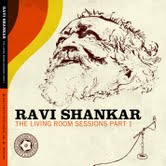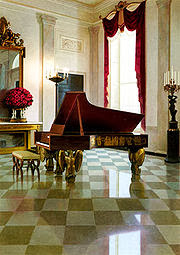In review--Living Room Ragas
The Living Room Sessions, Part 1
East Meets West Music/Harmonia Mundi
Release: April 10, 2012
It’s not every weekend I get to sit down and listen to new ragas performed by a 91-year old master musician. Pandit Ravi Shankar turns 92 this month and his raga performances sound equally fiery as they do thoughtful and tender. The master Indian classical musician gives the impression in his liner notes that The Living Room Sessions was a casual get-together with his friend tabla player Tanmoy Bose, but even one listen to this recording and we can hear the formalities of the Indian classical music tradition shining forth. “This rather a different recording when, at almost 92-years, I was fooling around at home in Encinitas.”
Also in the liner notes, “...Raga Malgunji has both a slow Vilambit gat and a display in Jhaptal of ten beats in complicated, rhythmic patterns and finishes that conveys sadness the sadness of not being able to merge with the Supreme.” The result of this recording is not that of a casual jam session, but of a musician who has mastered his sitar and emotions to the point that he can pull out several emotions for a single raga--an amazing fete. I'm impressed. I listen to these ragas and I nearly fall out of my seat from astonishment. Not that I should feel astonished since I have heard Ravi Shankar’s ragas on numerous occasions and I'm always moved by them. However, the critical part of my brain completely shuts off when it relaxes to this beautiful and spirited music.
The Living Room Sessions includes 4 of the 7 ragas that were recorded in Shankar’s Californian home last fall. The first Raga Malgunji is the most soulful of the 4 performed with tenderness and maturity bordering on sage wisdom. Similar to the closing track, Raga Satyajit (a raga composed for the late Indian filmmaker Satyajit Ray), portrays a meditative and contemplative mood. In fact, I made the mistake of lying down when I listened to the closing track and I fell asleep. The sleep felt healing. What I didn’t notice the first time I listened to the last raga was that at around 8 minutes into the raga, the tempo picks up with the sitar continuing the call and response of the main theme and Bose’s tabla contributing a gentle pulse throughout.
Raga Khamaj and Raga Kedara represent the lighter and more playful thumri. You can almost hear a smirk playing upon Ravi Shankar’s lips as he plays these spritely ragas. The playful ragas contrasts nicely with the tinges of melancholy present in the other ragas. If the point was to achieve an emotional balance on this recording, the musicians succeeded. I was expecting this recording to blow me away and the musicians met my expectations and then some. If you’re not a fan of Ravi Shankar yet, you will be after listening to The Living Room Sessions, Part 1.
Bring on Part 2.




Comments
Post a Comment